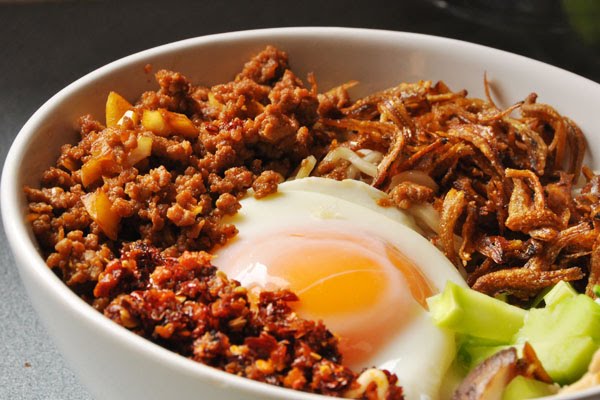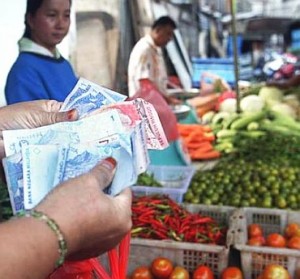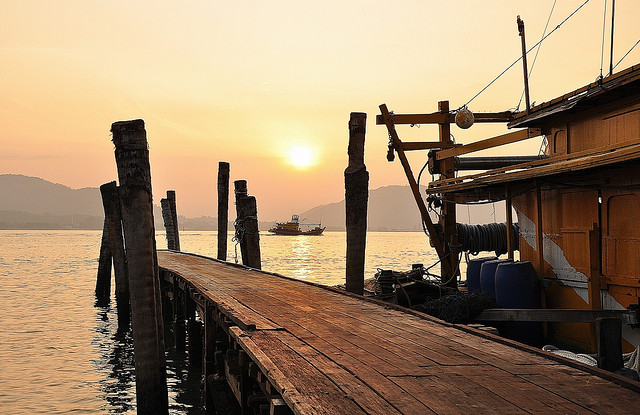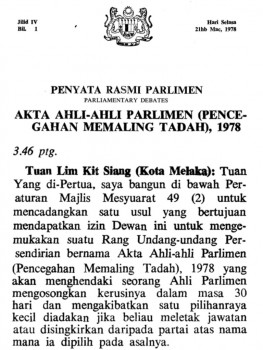by Howard Lee
 We often hear of, and even utter ourselves the words “it ain’t what it used to be”, when we speak of local dishes and local ingredients. It often follows with “they don’t make it like they use to, and so much more expensive nowadays”.
We often hear of, and even utter ourselves the words “it ain’t what it used to be”, when we speak of local dishes and local ingredients. It often follows with “they don’t make it like they use to, and so much more expensive nowadays”.
I’d like to contest that and elaborate on some gastronomical-psychological theory to disprove it; but I’d be lying, or at least in the Malaysian context anyway.
However I was pleasantly surprised by a hawker named “Plump Panther” who actually touched the bottom of my heart today when I had my breakfast this morning at a Pasir Pinji coffee shop on Prince Street.
It was a conversation that restored my faith in food and beverage hawkers that took place over a very masterfully crafted bowl of “Chilli Pan Mee”. It’s not the first time I had this beauty of a breakfast dish; I can testify for its consistency of delivery from at least four occasions over a period of 15 months.
For those who are unfamiliar, it is a popular dish widely consumed for breakfast, lunch and dinner of homemade pasta/noodle that is ‘presse a la minute’(rolled and cut to order). In this case, it is laced with a ground and roasted chilli and dark soy infusion, stir fried minced meat, crispy dried anchovies (ikan bilis), enriched with a anchovy & chicken broth which is then emulsified with the yolks of two perfectly poached eggs.
The ground chillies are grown and air-dried by a smallholder in Menglembu. The dark soya sauce is brewed by a factory that originated from Pasir Pinji but have expanded out to the outskirts of the city. The sweet potato leaves in the chicken and anchovy broth is from a farm just down the road from his home.
The crispy anchovies are from Pangkor and air dried in Pantai Remis. The composition of this dish tells a personal story and paints a very beautiful picture of about the Perakean landscape. Other than the flour, this dish is truly 100% made and grown in Perak.
You have to see it to believe it, taste it to understand it; it is absolutely heaven! If I was a Michelin guide inspector, and if there was a Malaysian Michelin Guide, this would definitely get at least one star. But my excitement isn’t over its imaginary Michelin Star, but the words he uttered over our conversation.
Why buy local
When I questioned him on how feasible it is to buy local anchovies from Pangkor, that are often edging on double the price of their Vietnamese and Thai equivalent (Vietnamese wholesale at average of RM30/kg and local Pangkorean at RM70/kg); he cut me short by telling me that what he pays extra, he gets far better quality in return. It sent shivers down my spine.
In this day in age, where foreign players flood local markets with substandard commodities for the sake of winning price wars and thereby drowning local producers from offering high quality products, it is rare to find small holders who take pride in using and offering locally sourced and produced goods.
On the same token, when competition is stiff within the local context, factors that often drive good food businesses such as quality, consistency, uniqueness are often substituted with quantity, haphazardness and monotony and the same old inferiority. It’s a self-perpetuating vicious cycle in the guise of ‘market-forces-driven’ commodity trade.
Gone are the days when local dishes evolve and grow in popularity in accordance with the availability of fresh local ingredients and its continued growth in depth of quality in production. Integrity and pride is no longer affordable; Its now a free-for-all race to the bottom, where the cheapest wins and the best is relegated or assimilated for the sake of survival.
Yet, to still see a hawker speak of, as well as literally put his money where his mouth is, it gives me that warm and fuzzy feeling of motivation to work harder as a legislator to ensure local agricultural producers are not only protected but helped to grow as operators develop a new generation of artisan foodstuff producers.
There are countless studies worldwide that proves that local money spent on local businesses and local produce and products, creates a stronger local economy; which in turn means more local jobs and therein feeding a virtuous cycle. This is no-brainer to ensure our local economy can prosper and local businesses can thrive with more sustainable and equitable fruits to their labour.
More importantly, this virtuous cycle is the one and only way to combat the vicious cycle the status quo promotes. Ultimately, this could ensure my future generations and I can continue to enjoy the fruits of the artisan gastronomy of my friend Plump Panther, and the inheritors of his trade and craft as an ‘Artisan Food Professional’ .
Herein, we see a few intrinsic issues;
Market model
‘Market forces’ are often the biggest enemies of local agricultural businesses and growers. The habitual consumer culture by and large, of letting prices be the single most important purchase motivator, ignoring quality, safety, sustainability and all else presents a vicious cycle for the agricultural industry in general.
Regulatory & Governance
The lack of governance and market regulating mechanisms perpetuates the problems therein, allowing exploitative enterprises to utilise the weaknesses of neighbouring countries’ currency, and cheap labour against ours to colonise huge proportions of market shares of certain produce, endangering the food security of the exporting country’s as well as our own.
Cultural factors
The growing dietary globalisation, less than deserved glorification of imported goods, and a decreasing awareness and care for food source and traceability has brought about a consumption culture that serves to deepen the silent food crisis.
Out of these issues, lackadaisical research and development in the agricultural industries especially on non-cash crops produces lackadaisical progress and improvements in productivity and output; all leading towards the lackadaisical reality that we see afore us.
It is absolutely essential that we identify the economic dynamics behind this seemingly nonsensical phenomena of ‘imported goods cheaper than their locally produce counterparts’, so that we can come up with a more economically and environmentally sustainable model of supply and consumption.
To distill the challenges posed by the above factors, there are indeed several existing governance models of which this can be learnt from.
The cause is two fold, especially in the food business.
The absence of government policy to engender and assist the agricultural smallholder community in innovating their methods to gain more value and productivity. This in turn leaves no choice to these smallholders but to compete in price, since there is little they can offer in terms of differentiation in quality and character.
Though this is not a blanket case across all agricultural produce, this phenomena would draw little debate in its verification. All in all, the affordability and availability of ingredients and fresh produce consumed by the F&B industry, as well as households is at the mercy of the price wars between local producers and the global commodity exporting giants like China and even Thailand.
Local growers can’t keep up with commodity dumping
 Whilst we hear and see great protests against the USA on the Trans Pacific Partnership Act (TPPA) and how it may cause damage to our local economy, ‘commodity dumping’ or the flooding of foreign produced commodities (which can also be produced locally, but the foreign goods are much cheaper) is something that is happening right now and has been so for a long time.
Whilst we hear and see great protests against the USA on the Trans Pacific Partnership Act (TPPA) and how it may cause damage to our local economy, ‘commodity dumping’ or the flooding of foreign produced commodities (which can also be produced locally, but the foreign goods are much cheaper) is something that is happening right now and has been so for a long time.
The general discourse in Malaysia is like an alcoholic man warning the world of brain cancer if the planning application for a Telco tower is approved at his doorstep whilst he drinks himself to an early death from liver cancer. Both cancers are lethal, but the immediate problems are ignored.
If TPPA, which is a deal that has yet to be signed, commands such loud contesting voices, this phenomena of commodity dumping that is happening in front of our eyes deserves equal if not more attention and debate.
Succumbing to imports that are lower in price will just slowly but surely squeeze local producers to the point of desertion of their trade. And when our local markets are starved of local supply of a commodity yet maintain a growing demand, the end consumer will be at the mercy of the foreign producers as well as the importers’ dictates in the guise of ‘market forces’.
One only needs to spend a small amount of time at a Pasar Borong and also talk to local market traders to see the extent this phenomenon is affecting our local agricultural producers.
Whilst some may argue that if this brings lower prices to the end consumer, it’s a temporary but necessary evil; I am of the view that if we can produce it locally, why can’t we empower the locals and help increase their productivity and ultimately our own sustainability and be free of foreign market influences?
What we see right now, is a situation where smallholders who collectively play a crucial role in stocking up our Pasar, are systematically sidelined as they are unable to secure finances to fund capital expenditure for productivity gains using technology.
Having no security in their primary asset as they are given temporary operating licenses of , namely the land on which they produce, State governments need to overhaul land policies to enable agricultural smallholders to securely and safely invest in their businesses.
Is imported really better?
The other fold in this discussion is the intrinsic 20th century consumer culture, built over decades and maybe even the last two centuries, borne from a mostly unfounded inferiority complex notion. Somehow we seem to believe that imported is premium and exotic, local is inferior and dull.
It is cringe-worthy to hear radio advertisements, proudly selling restaurants’ unique propositions of ‘freshly flown in’ Salmon from Alaska and ‘freshly picked’ English Asparagus. The reality is very far from ‘fresh’.
The salmon once having taken a plane ride from Alaska, even with the most advanced cryogenics would mean it would have travelled a good 10,000 km or a bare minimum of 14 hours on a plane from the fishermans boat to your dinner table; this is not taking into account the sea to land transit, the several hours of haggling at the fishmarket, then the plane. What about the land transport from airport to wholesaler before it ends up the kitchens of said restaurants? -The Rocket




